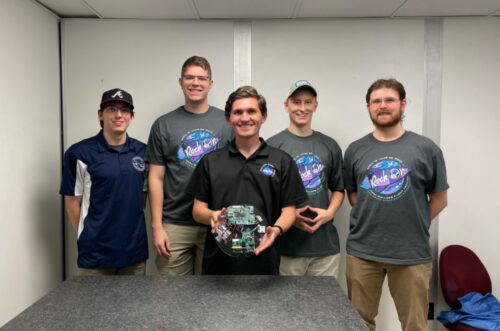A piece of equipment that has been to space and back was conceived and constructed by a group of students from the University of Alabama in Huntsville’s Space Hardware Club!

The students created a payload that was launched into space on June 24, 2022, using a Terrier-Orion rocket from NASA’s Wallops Flight Facility in Virginia. “Knowing that I put components onto a little board using solder and then it went up into space, and is coming back down and then we’re actually getting it back as well is cool,” said Tristan Carter, a senior Mechanical Engineering student. “I’ll actually be able to touch something that I put into space.”
On June 24, the payload launched alongside 32 other university student projects in the NASA RockOn and RockSat-C programmes aboard a Terrier-Orion rocket from NASA Wallops Trip Facility in Virginia to a suborbital flight to space and returned. As part of the Terminus Spaceflight Research Group (TSRG), the students are currently evaluating the data from the flight monitoring apparatus they developed.
“We were really happy it worked and we had data available the same day it launched,” says Ben Campbell, a master’s student in aerospace systems engineering who is TSRG’s founder and project manager. “At the moment, we have a large collection of raw data that was recorded by all the sensors, and we are now in the process of correlating everything together to basically produce the big picture, or life story, of what our payload experienced during the mission,” Campbell says.
“We have things worked out for the initial ascent phase of the launch, where we have clear data indicating events such as the operation of the two stages that were used on the launch vehicle, and our crossing of the Karman line – which is the boundary of space that’s about 100 kilometers above sea level – at around 114 seconds after liftoff.”
“The payload was essentially a small deck of electronics, about the size of a dinner plate, which hosted a suite of various sensors to monitor flight conditions throughout the mission,” Campbell says. Sensors onboard included:
- Accelerometers for detecting linear motion and forces on the spacecraft
- Gyroscopes for detecting the rotation rate of the spacecraft
- A barometric pressure sensor for determining the altitude while in the atmosphere
- A temperature sensor for monitoring onboard temperature throughout the flight
- A humidity sensor for detecting air moisture content while within the atmosphere
- A Geiger counter to count captured radioactive particles from space intercepted by the spacecraft.












